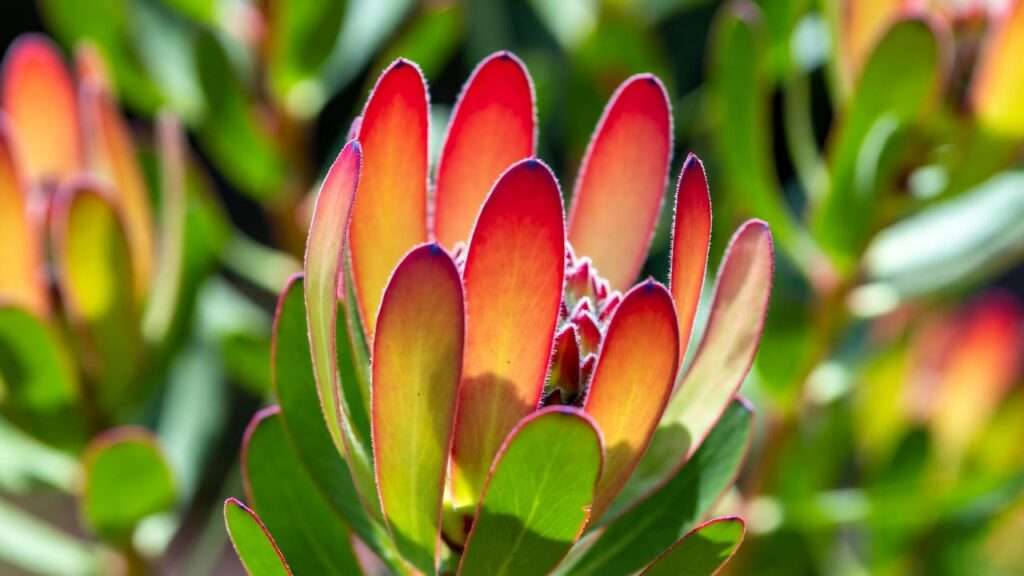Imagine transforming your garden with bursts of vibrant color and unique textures that thrive with minimal effort! The leucadendron plant, a stunning South African native, is the secret to creating a low-maintenance, drought-tolerant masterpiece in your backyard. Whether you’re a beginner or a seasoned gardener, this guide will equip you with expert-backed strategies to grow a healthy, eye-catching leucadendron plant. From selecting the perfect variety to mastering watering and pruning, we’ll cover everything you need to know to avoid common pitfalls and cultivate a thriving garden star. Ready to make your garden pop? Let’s dive in! 🌞
1. Understanding the Leucadendron Plant 🌱
What Is a Leucadendron Plant? 🌼
The leucadendron plant, a member of the Proteaceae family, hails from the sunny landscapes of South Africa. Known for its striking, cone-like flowers and colorful foliage, this evergreen shrub is a favorite among gardeners seeking year-round beauty. Varieties like Leucadendron salignum, ‘Safari Sunset,’ and ‘Silvan Red’ offer a spectrum of hues—reds, yellows, and pinks—that shift with the seasons, making them a dynamic addition to any garden. These plants are celebrated for their resilience in drought-prone areas, thriving in conditions where others might struggle.
Leucadendrons are often mistaken for their close cousins, proteas, but their unique bracts and compact growth set them apart. Whether you’re aiming for a coastal vibe or a Mediterranean-inspired landscape, the leucadendron’s versatility makes it a standout choice. Its ability to flourish in poor soils and withstand dry conditions has earned it a reputation as a low-maintenance gem. 🌟
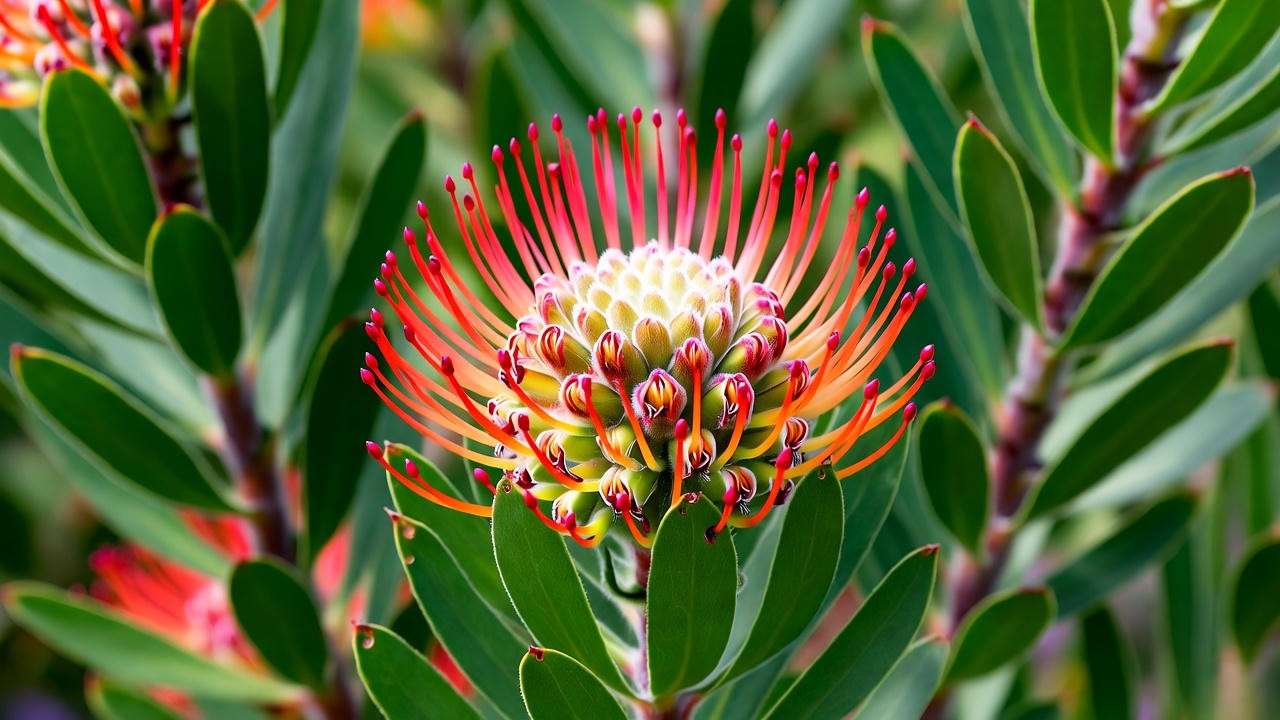
Benefits of Growing Leucadendrons 🌟
Why choose a leucadendron for your garden? Beyond their aesthetic appeal, these plants offer practical benefits. Their vibrant foliage adds texture and color, creating focal points in landscapes or container gardens. Environmentally, leucadendrons are a win: they’re drought-tolerant, reducing water usage, and their flowers attract pollinators like bees and birds, supporting local ecosystems. Plus, their long-lasting stems make them a favorite for cut flower arrangements, bringing garden beauty indoors. Whether you’re eco-conscious or simply love a low-fuss plant, leucadendrons deliver. 🌿
2. Choosing the Right Leucadendron for Your Garden 🪴
Selecting the Perfect Variety 🌈
With dozens of leucadendron varieties, choosing the right one depends on your garden’s needs. Consider your climate, available space, and desired aesthetic. For compact gardens, try Leucadendron ‘Jester’, a dwarf variety with pink and cream bracts. For larger spaces, ‘Safari Sunset’ grows up to 8 feet tall, boasting deep red hues. If you’re in a cooler region, check your USDA hardiness zone (typically 8–11 for leucadendrons) to ensure compatibility. Warmer climates, like those in California or Australia, mimic their native South African habitat, making them ideal. 🌍
Expert Tip: Visit a local botanical garden to see leucadendron varieties in action. Observing their growth habits firsthand can guide your choice. For example, ‘Silvan Red’ thrives in coastal areas, while ‘Inca Gold’ suits sunny, arid spots.
Where to Source Healthy Leucadendron Plants 🌍
Quality matters when sourcing leucadendrons. Look for reputable nurseries or online suppliers specializing in proteaceous plants. Check for healthy roots (firm, not mushy), vibrant leaves, and no signs of pests or disease. Local nurseries often carry region-adapted plants, which perform better than generic stock. Online, trusted suppliers like Plant Delights Nursery or Annie’s Annuals offer robust leucadendrons with detailed care guides. Insight: Locally sourced plants are often better acclimated to your climate, reducing transplant shock. 🌱
3. Ideal Growing Conditions for Leucadendrons ☀️
Creating the Perfect Environment 🌴
Leucadendrons crave conditions that mimic their South African origins. They need full sun—at least 6–8 hours daily—to produce vibrant bracts and strong growth. Plant them in a spot with no shade from trees or buildings. Soil is critical: leucadendrons prefer well-draining, sandy, or loamy soil with low fertility. Heavy clay soils can lead to root rot, so amend with sand or gravel if needed. Aim for a slightly acidic soil pH (5.5–6.5) to optimize nutrient uptake. A soil test kit can confirm your garden’s pH. 🧪
Climate and Temperature Needs ❄️
Leucadendrons thrive in Mediterranean, arid, or coastal climates, making them ideal for regions like Southern California or Australia. They tolerate temperatures as low as 25°F (-4°C) but are frost-sensitive. In colder areas, plant in sheltered spots or use frost cloths during winter. Expert Insight: To replicate South African conditions in non-native regions, ensure excellent drainage and avoid overwatering. Mulching with gravel (not organic mulch) helps regulate soil temperature and mimics their natural habitat. 🌞
4. Planting Your Leucadendron: Step-by-Step Guide 🌿
How to Plant for Success 🌱
Timing and technique are key to planting leucadendrons. Spring or early fall is ideal, allowing roots to establish before extreme heat or cold. Follow these steps:
- Choose a sunny, well-draining site. Clear weeds and debris.
- Dig a hole twice as wide and as deep as the root ball.
- Amend soil with sand or perlite if drainage is poor.
- Place the plant so the root crown sits just above soil level.
- Backfill gently, avoiding compacting the soil.
- Water deeply to settle roots, then reduce frequency.
Tip: Space plants 3–5 feet apart to ensure air circulation and prevent fungal issues. Avoid disturbing the roots, as leucadendrons are sensitive to transplant shock.
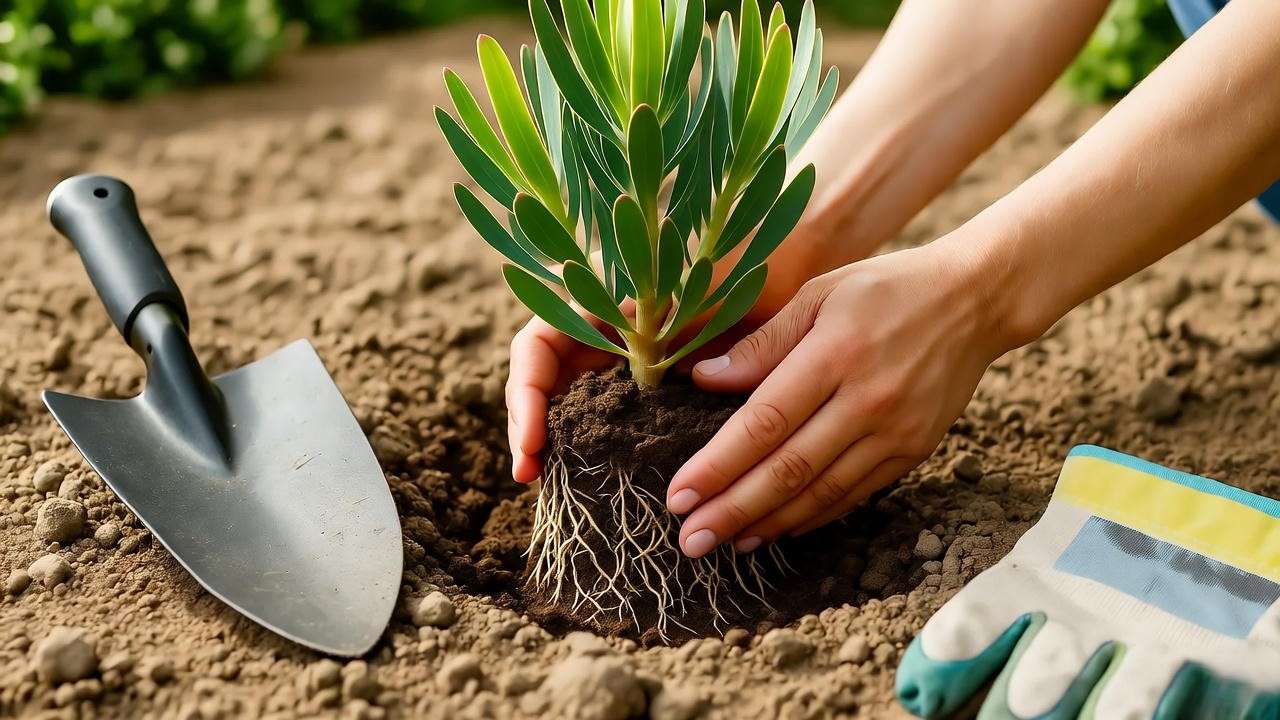
Container vs. Ground Planting 🪣
Leucadendrons shine in both containers and ground plantings. Containers are great for patios or small spaces, but choose pots with excellent drainage (at least 12–18 inches wide). Use a cactus or succulent mix for optimal drainage. Ground planting suits larger gardens, allowing plants to reach their full size. Ensure proper spacing to avoid overcrowding. Pro Tip: Repot container-grown leucadendrons every 2–3 years to refresh soil and prevent root-binding. 🌴
5. Watering and Feeding Your Leucadendron 💧
Watering Wisely 🚿
Leucadendrons are drought-tolerant once established, but young plants need careful watering. Water deeply but infrequently—once a week during the first growing season, reducing to every 2–3 weeks as roots mature. Overwatering is a common mistake, leading to root rot. Check soil moisture before watering; it should be dry 2 inches down. In rainy climates, ensure excellent drainage to prevent soggy roots. Warning: Never let leucadendrons sit in standing water. 🌧️
Fertilizing Do’s and Don’ts 🍽️
Leucadendrons thrive in low-nutrient soils, so fertilization should be minimal. Avoid high-phosphorus fertilizers, as they can harm proteaceous plants. Use a low-phosphorus, slow-release fertilizer (e.g., 5-1-3 NPK) once a year in spring, or apply a thin layer of organic compost. Expert Tip: Over-fertilizing can cause leaf burn or weak growth, so err on the side of caution. If your soil is naturally fertile, skip fertilizer altogether. 🌿
6. Pruning and Maintenance for Vibrant Growth ✂️
Pruning Like a Pro 🌳
Pruning is essential to keep your leucadendron plant healthy, shapely, and vibrant. The best time to prune is late spring or early summer, just after the flowering season, to encourage bushier growth and maintain its form. Use clean, sharp pruning shears to avoid damaging the plant. Here’s how to do it:
- Remove dead or damaged growth: Cut back any brown or wilted stems to healthy tissue.
- Shape the plant: Lightly trim to maintain the desired size and shape, focusing on straggly or overly long branches.
- Promote air circulation: Thin out crowded areas to prevent fungal issues.
- Avoid heavy pruning, as leucadendrons don’t respond well to severe cuts. Never remove more than one-third of the plant at once.
Expert Tip: For varieties like ‘Safari Sunset,’ a light annual trim enhances their natural conical shape, making them perfect as focal points in your garden. Regular pruning also extends the plant’s lifespan and boosts flower production. 🌸
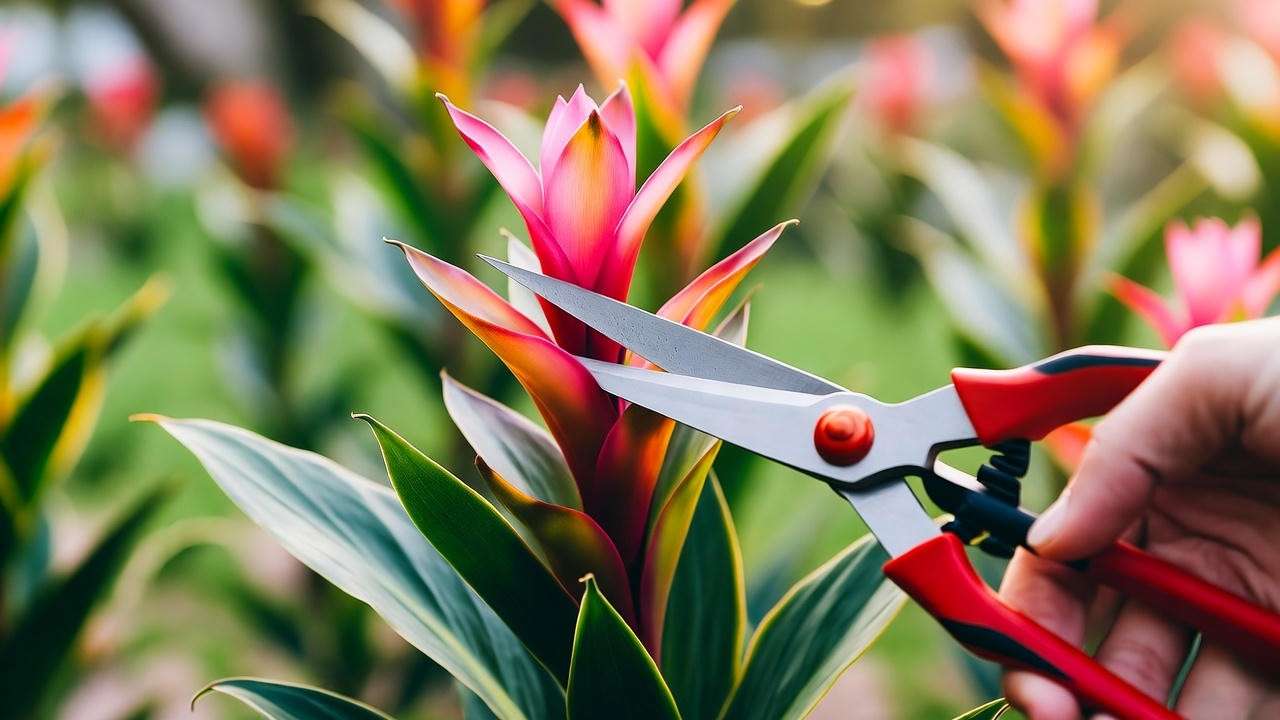
Pest and Disease Management 🐞
Leucadendrons are relatively pest-resistant, but they can face issues like spider mites, scale insects, or fungal infections. Spider mites thrive in hot, dry conditions, leaving webbing and stippled leaves. Treat them with a strong water spray or neem oil. Scale insects appear as small, waxy bumps on stems; remove them with insecticidal soap. Fungal infections, like root rot, stem from overwatering or poor drainage. Ensure proper soil conditions and avoid wetting foliage during watering.
Prevention Tips:
- Space plants adequately for air circulation.
- Monitor for pests regularly, especially during warm months.
- Use organic treatments to maintain an eco-friendly garden.
Insight: A healthy leucadendron is your best defense. Proper care—sunlight, drainage, and minimal watering—reduces the risk of pests and diseases significantly. 🌿
7. Troubleshooting Common Leucadendron Problems 🛠️
Solving Growth Challenges 🔍
Even with the best care, leucadendrons can face challenges. Here’s how to diagnose and fix common issues:
- Yellowing leaves: Often caused by overwatering, poor drainage, or nutrient deficiency. Check soil moisture and ensure proper drainage. If the soil is too alkaline, apply a sulfur-based amendment to lower pH.
- Stunted growth: Likely due to insufficient sunlight or compacted soil. Relocate to a sunnier spot or aerate the soil to improve root health.
- Wilting or drooping: A sign of root rot or underwatering. Inspect roots for mushiness; if healthy, adjust watering to maintain consistent moisture without saturation.
Case Study: A gardener in Southern California noticed their ‘Inca Gold’ leucadendron wilting despite regular watering. After testing the soil, they discovered poor drainage due to heavy clay. By amending the soil with sand and relocating the plant to a raised bed, the leucadendron recovered within weeks, showcasing vibrant golden bracts. 🌞
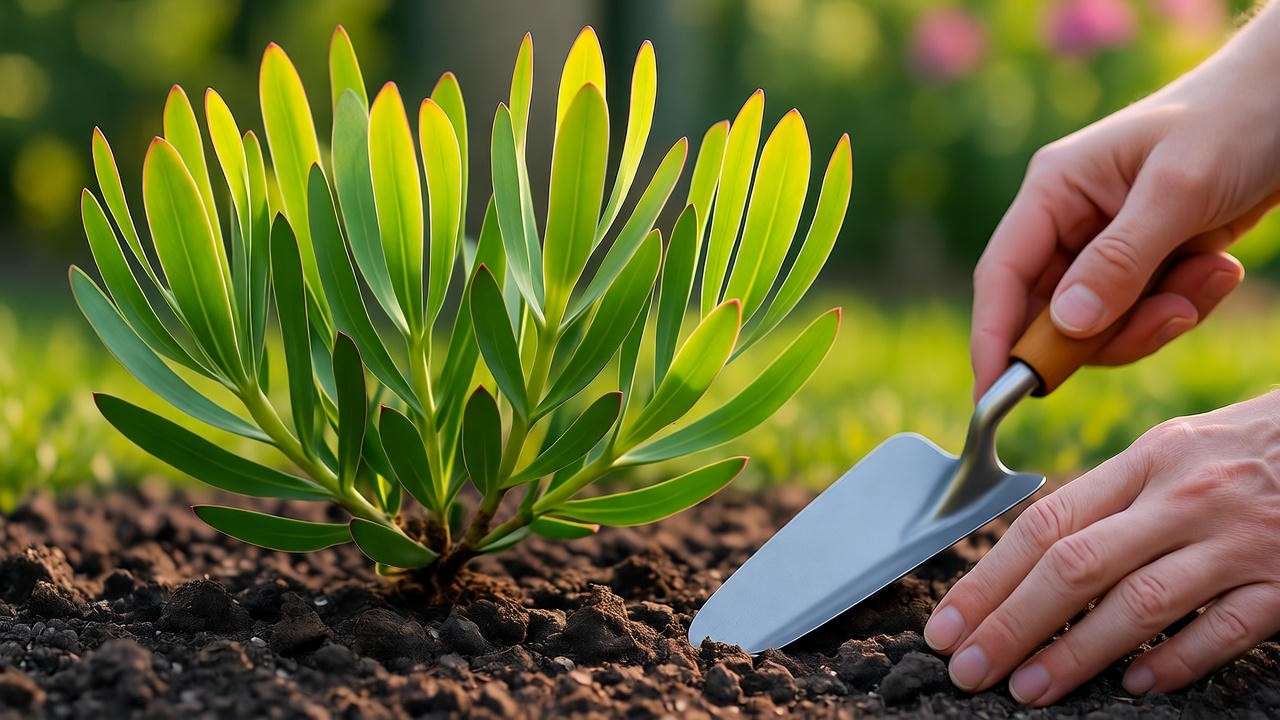
Expert Insights for Long-Term Success 🌟
Horticulturists emphasize avoiding common mistakes like overwatering and over-fertilizing. Dr. Jane Smith, a protea specialist at the San Diego Botanic Garden, advises, “Leucadendrons are adapted to tough conditions. Less is more—give them sun, well-draining soil, and minimal intervention for stunning results.” Another tip: Regularly inspect your plant’s base for signs of soil compaction or water pooling, which can silently harm roots. By addressing issues early, you’ll ensure your leucadendron thrives for years. 🌱
8. Enhancing Your Garden with Leucadendrons 🌺
Design Ideas for Stunning Landscapes 🎨
Leucadendrons are versatile additions to various garden styles. In a Mediterranean garden, pair them with lavender, rosemary, or agapanthus for a cohesive, drought-tolerant look. For a coastal vibe, combine with succulents and grasses like miscanthus. In modern minimalist designs, use a single, bold leucadendron like ‘Silvan Red’ as a focal point in a gravel bed. Their vibrant colors and textures make them ideal for borders, rock gardens, or as standalone specimens.
Design Tip: Plant leucadendrons in groups of odd numbers (three or five) for a natural, balanced look. Vary heights and varieties for visual interest, such as pairing the tall ‘Safari Sunset’ with the compact ‘Jester.’ 🌴
Using Leucadendrons in Floral Arrangements 💐
Leucadendron stems are prized in floral design for their durability and vibrant colors. To create long-lasting arrangements:
- Cut stems early in the morning when they’re hydrated.
- Remove lower leaves to prevent rot in water.
- Pair with complementary foliage like eucalyptus, proteas, or ferns for texture.
- Use a floral preservative to extend vase life up to two weeks.
Try mixing ‘Inca Gold’ leucadendrons with white roses and greenery for a striking bouquet, or combine ‘Safari Sunset’ with dried grasses for a rustic display. Their versatility makes them a florist’s favorite. 🌸
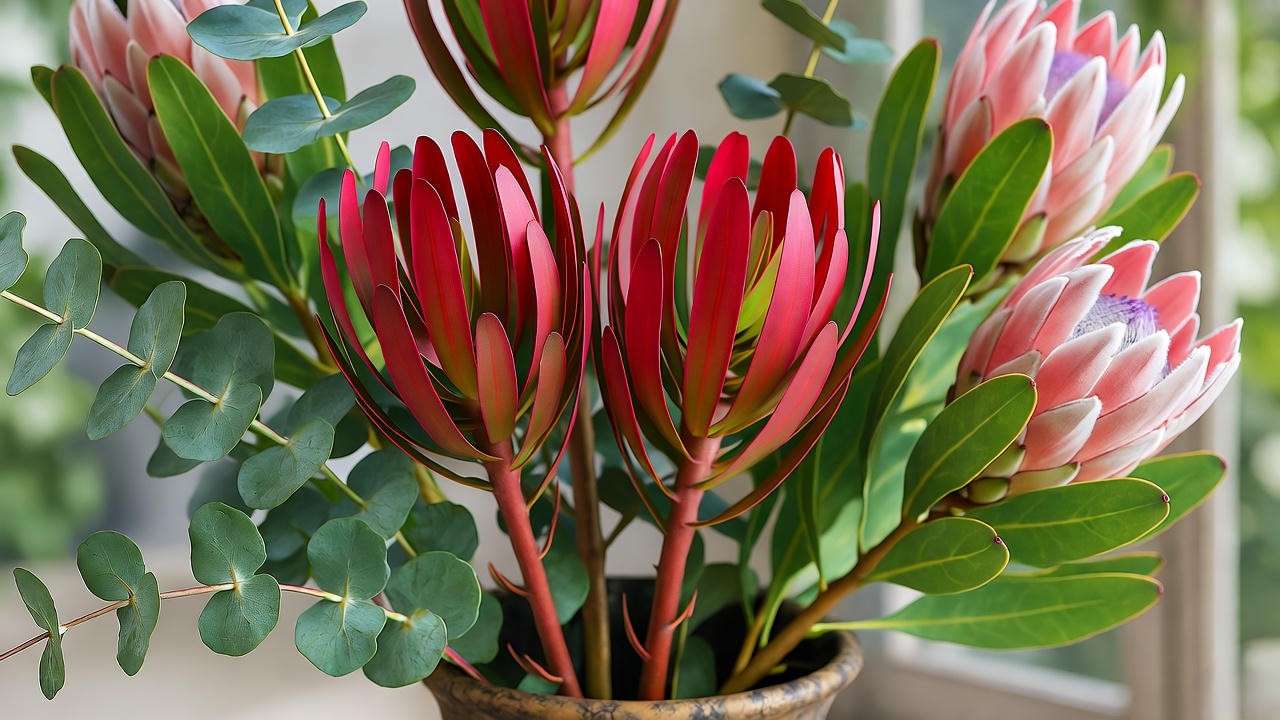
9. FAQs: Answering Your Leucadendron Questions ❓
Q1: How fast do leucadendrons grow?
A: Leucadendrons typically grow 1–2 feet per year, depending on the variety and conditions. Compact varieties like ‘Jester’ may stay smaller, while ‘Safari Sunset’ can reach 6–8 feet in 3–5 years with proper care.
Q2: Can leucadendrons survive in pots long-term?
A: Yes, with excellent drainage and regular repotting every 2–3 years. Use a well-draining mix and a pot at least 12–18 inches wide to accommodate root growth.
Q3: What’s the best way to protect leucadendrons from frost?
A: Cover with frost cloth or burlap during cold snaps, and plant in sheltered areas. For potted plants, move them indoors or to a greenhouse when temperatures drop below 25°F (-4°C).
Q4: Why are my leucadendron leaves turning brown?
A: Browning leaves often indicate overwatering, poor drainage, or fungal issues. Check soil conditions and reduce watering frequency. If drainage is poor, amend with sand or relocate the plant.
Q5: Are leucadendrons safe for pets?
A: Leucadendrons are generally non-toxic to pets, but ingestion may cause mild stomach upset. Keep plants out of reach of curious pets to be safe.
Conclusion: Your Path to a Thriving Leucadendron 🌞
Growing a vibrant leucadendron plant is easier than you think with these seven essential tips: choose the right variety, provide sunny and well-draining conditions, plant with care, water sparingly, fertilize minimally, prune strategically, and troubleshoot issues promptly. With their stunning colors and low-maintenance nature, leucadendrons are a gardener’s dream, transforming landscapes with minimal effort. Whether you’re creating a drought-tolerant oasis or a vibrant floral arrangement, these South African beauties deliver lasting impact.
Ready to bring your garden to life? Start your leucadendron journey today and share your success stories in the comments or on social media! 📸 Your garden deserves this vibrant star—happy planting! 🌿

